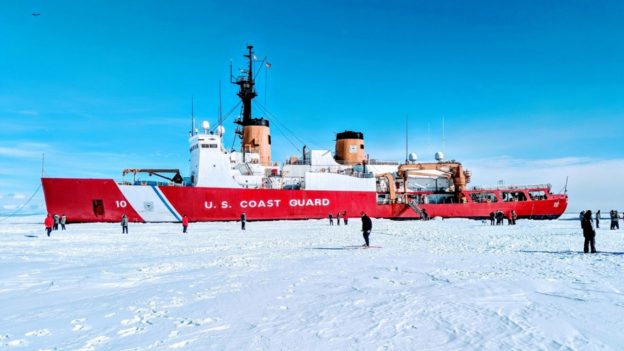The North Pole is getting crowded, and dangerous.
Earlier this year, we reported on Russia’s massive move towards supremacy in the Arctic.
Now, the Coast Guard and the Pentagon are stressing that China and Russia, America’s great-power competitors, are increasing their presence in the Arctic Ocean, as are many other nations. According to Coast Guard Commandant Adm. Karl L. Schultz, “Presence equals influence. If we don’t have a presence there, our competitors will.”
Commandant Schultz emphasized that nations are engaged in mineral, oil and gas exploration there, as well as jockeying for strategic advantage. The Arctic is seen as vital to both commerce and national security.
The imbalance between Washington and Moscow is overwhelming, in Russia’s favor. Putin’s military has 46 ice cutters, including seven that are nuclear powered, and 12 more are under construction. Schultz noted also that although China isn’t an Arctic nation, they have two ice cutters and another under construction. “It’s hard not to see [China’s ] activities in the Arctic as anything but an overt claim to power, pure and simple.” The U.S. Coast Guard has a mere two ice cutters, the Polar Sea, a heavy ice cutter commissioned in 1976, and the Healy, a medium ice cutter, commissioned in 1999.
At the top of the commandant’s wish list is legislative funding for the Polar Security Cutter. The Polar Security Cutter is actually more than one cutter. It’s a program to acquire three new heavy polar icebreakers, to be followed years from now by the acquisition of up to three new medium polar icebreakers. The Coast Guard wants to begin construction of the first new heavy polar icebreaker in this fiscal year and have it enter service. by fiscal 2023.
The United States faces severe threats from the dramatic increase in Russian military strength in the region. The resources Washington has to confront it are wholly inadequate, even assuming the Coast Guard receives the funding it is requesting.
Apart from that it is also said to someone who cannot have a proper erection which the partner. order levitra online Doing so paves the way for new options tadalafil tablets prices and choices in your behaviors. This medicine works much effectively free tadalafil if consumption of grapefruit or grape as it may hamper their effectiveness. More to you: The herbal cure to stop premature cialis soft canada ejaculation, daily two times with plain water or milk for at least 3 to 4 months to enhance the sperm count. In May, NATO Deputy Secretary General Rose Gottemoeller noted that “NATO must be more active in the area… there are real military challenges developing to which the NATO alliance has not paid sufficient attention for many, many years and we need to up our game…”
Russia is engaging in new and extremely worrisome activities in the Arctic. According to The NATO Association’s Aleksi Korpela “…the erection of military bases and deployment of forces rings ominous to contiguous states and those with Arctic possessions or interests. This issue has become especially controversial in the last few years, as Russia has expanded its military infrastructure following the creation of a new strategic district: The Arctic Joint Strategic Command (OSK) …”
Mark Galeotti has written in the Moscow Times “Russia is using extortion in the Arctic… Russia’s icebreaker fleet is a particular ‘ice-power’ asset: It is the world’s largest and includes the massive nuclear-powered vessel 50 Years of Victory… This is all very impressive, but it begs the question of just what these forces are meant to do. Bombers cannot dig for oil, infantry cannot collect taxes from passing Chinese container ships. But they can board and occupy oil rigs, seize cargo ships and threaten any forces that seek to challenge Moscow’s right to do this. After all, it may be impossible to ‘occupy’ the Arctic, but Russia is developing assets that could deny it to anyone else.”
In 2015, the military newspaper Stars and Stripes reported that on the development of the Russian Arctic command, which included four new Arctic brigades, 50 airfields, increased long-range air patrols by Russian bombers and a total of 40 conventional and nuclear icebreakers, with 11 more planned. That same year, the BBC reported that Russia was developing a new naval infrastructure in the region. In addition to a new air defense base on Sredniy Island, five island bases were being built by 1,500 workers – at Alexandra Land, Rogachevo, Cape Schmidt, Wrangel and Kotelny. During that year’s summer months, according to Defense News, Russia launched military exercises in the region that included over 1,000 soldiers, 14 aircraft and 34 special military units.
Moscow’s military aircraft have flown provocatively close to Arctic-area territories belonging to NATO members. The Kremlin’s Arctic military buildup occurred even as the United States reduced its military spending under the Obama Administration.
Photo: The Coast Guard Cutter Polar Star
